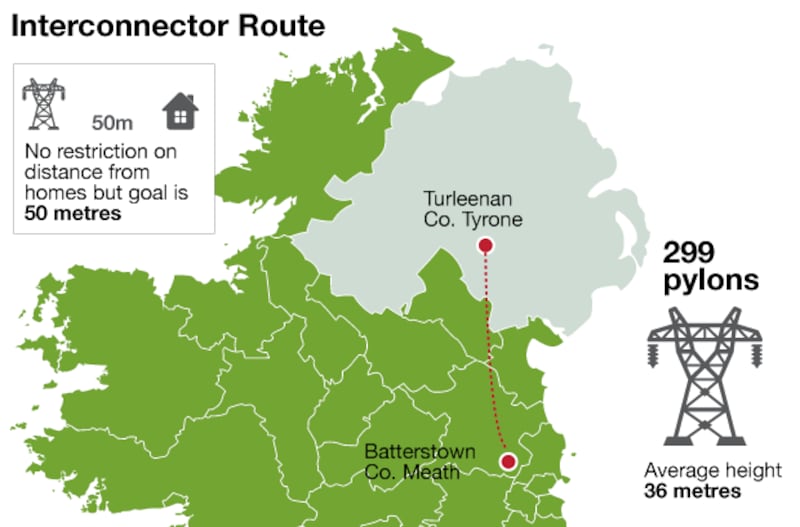A 135km high-power electricity link from Meath to Tyrone composed of almost 300 above-ground pylons will lead to “unavoidable” adverse effects on the landscape as well as some negative impacts on property prices, An Bord Pleanála has said.
The planning body on Wednesday gave EirGrid approval to proceed with the North-South Interconnector, which will link the existing electricity transmission network of the State in Co Meath with a planned substation in Co Tyrone.
The development will pass through Monaghan, Cavan and Meath, comprising a new single-circuit overhead transmission line of 100.5km. It will entail the construction of 299 pylons ranging in height from 26m to 51m.

In its more than 600-page report, An Bord Pleanála dismissed the objections of 200 landowners, and said the strategic need for the development had been established. “It will remove the bottlenecks and constraints that currently exist,” it said.
The project will also allow the Republic and the North to “expand green energy productions” to meet international obligations and support sustainable economic growth in both jurisdictions.
No cancer link
A “large number of submissions” were received on public health, but the research showed no causal link between exposure to electromagnetic fields and the development of leukaemia and a range of other cancers.
“While research carried out over an extended period has shown some association between long-term exposure to magnetic fields from high-voltage overhead power lines and an increased prevalence of childhood leukaemia, the health effects are unproven.” The report did “not accept” that there was no objective analysis by EirGrid on health impacts.
The planning body said the development had been sited to maximise the distance to urban centres, local villages, clustered settlements, individual one-off houses, schools, churches and community facilities.
However, it said that in some situations there may be negative impacts on property prices in the immediate proximity to the development. These impacts “will likely diminish greatly or disappear completely over time”.
EirGrid has offered a once off “ex-gratia” payment to owners of residential property within 200m, with €30,000 for residences at 50m from the centre line of the development, decreasing on a sliding scale to €5,000 for residences at 200m.
On tourism, the report said the development was routed away from main attractions and will only have an adverse impact on a small number.
The operational stage will impact on the setting of monuments, buildings, structures and demesne lands, which “cannot be effectively mitigated”. The greatest impact will arise in the Brittas estate.
Unavoidable adverse effects
The development will cross the main avenue between the entrance gates and Brittas House, approximately 170m from the entrance into the demesne. A total of five towers will traverse the lands. “It is considered that the impacts are acceptable having regard to the wider benefits to the community,” the report said.
In terms of the landscape, it will result in “residual unavoidable adverse effects on character and unscreened views” within 600m to 800m. Some areas that are particularly elevated will experience “significant effects” up to 1km.
The landscape effects will be “particularly noticeable” where the line crosses roads, or where panoramic views are available.
There will be a “significant impact” on the amenity and enjoyment of about 600 properties falling within 500m of the development with “consequential long-term, adverse effects for the individuals and families affected”.
Overall however, the report said there would be no significant visual or landscape impacts in the wider area. The construction period is expected to extend over a period of three years.












